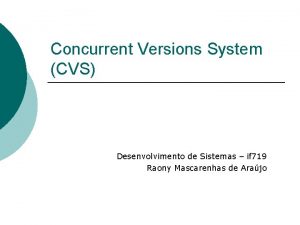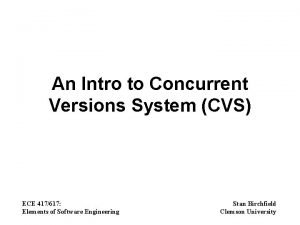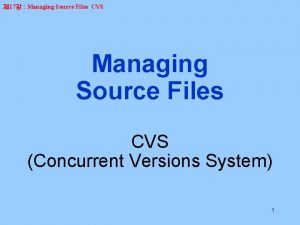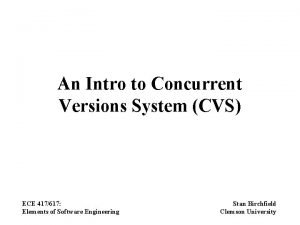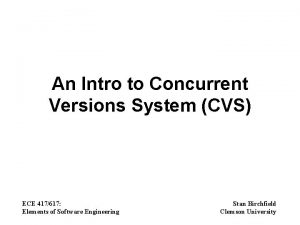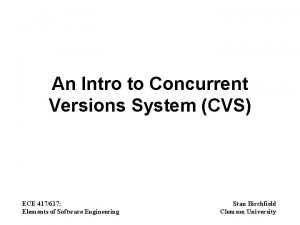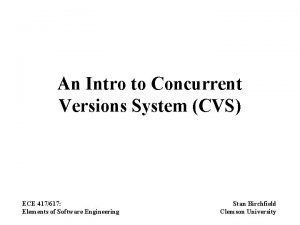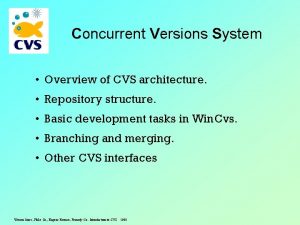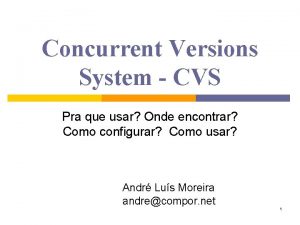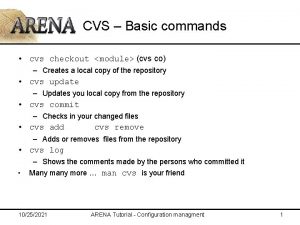An Intro to Concurrent Versions System CVS ECE







![CVS commands • Syntax: cvs [goptions] command [coptions] [arguments] • Example: cvs -d : CVS commands • Syntax: cvs [goptions] command [coptions] [arguments] • Example: cvs -d :](https://slidetodoc.com/presentation_image/769cd3ce07aa541c99621d6b276ab71b/image-8.jpg)










- Slides: 18

An Intro to Concurrent Versions System (CVS) ECE 417/617: Elements of Software Engineering Stan Birchfield Clemson University

What is CVS? • CVS – is a version (or revision) control system – maintains entire history of source file (for each change: who, when, and why) – is open-source and free (unlike Source. Safe) • What does it do? – – – stores entire history of each file efficiently allows multiple people to work simultaneously enables retrieval of old systems helps to manage different versions, releases works well over WAN (server/client) works for any ASCII file, and limited support for binary • What is it not? – a build system – a substitute for management or communication

Why CVS? • Problem: how to coordinate source file changes from multiple developers? – Solution #1: Manual merging and coordination – Solution #2: lock-modify-unlock (RCS, SCCS) – Solution #3: concurrent development (CVS)

How CVS manages changes • Scenarios: – People work on different files trivial – People work on different parts of the same file CVS essentially runs ‘diff’ – People work on the same part of the same file CVS alerts user, requires manual merging of changes

CVS model Server (UNIX/Linux) Local machine (any O/S) checkout, update, diff Respository: central, official copy, as well as entire history Local copy: used for editing add, remove, commit, tag Note: checkout is a one-time operation

CVS directory structure Repository on server /pub/cvsprojects/ece 417 | +--CVSROOT (admin. files) +--3 dmm | +-- data | +-- main. cpp, v | +-- database. cpp, v | +-- ui | +-- Main. Frame. cpp, v | +-- Settings. Dlg. cpp, v | +--klt-ui +--bibtex-manager. . . Copy on local machine C: /user/me/mycode | +--CVS (admin. files) | +--data +-- CVS (admin. files) +-- main. cpp +-- database. cpp +--ui +-- CVS (admin. files) +-- Main. Frame. cpp +-- Settings. Dlg. cpp Note: All information stored on a per-file basis

Pserver authentication • Each CVS command needs to authenticate you • Instead of a password for each command, first login • Steps: – cvs login (server checks its passwd file; if no passwd, then falls back to UNIX system authentication) – now your password is stored locally in ~/. cvspass – local password is automatically used in the future as long as it’s there – CVS_PASSFILE can be used to change location of. cvspass • Note: pserver authentication provides minimal security; do NOT use an important password
![CVS commands Syntax cvs goptions command coptions arguments Example cvs d CVS commands • Syntax: cvs [goptions] command [coptions] [arguments] • Example: cvs -d :](https://slidetodoc.com/presentation_image/769cd3ce07aa541c99621d6b276ab71b/image-8.jpg)
CVS commands • Syntax: cvs [goptions] command [coptions] [arguments] • Example: cvs -d : pserver: me@cvs. ces. clemson. edu: /pub/cvsprojects/ece 417 login • Common commands: – cvs checkout modules ; create private copy – cvs update ; incorporate others’ changes into private copy – cvs add file ; add private file to repository – cvs remove file ; remove file from repository – cvs commit file ; publish changes to others • Customizing: –. cvsrc file contains default options, both global and command-specific

Create / checkout module • To put a directory under CVS control, cvs import –m “New file” foo me start – All files in current directory are stored in foo subdirectory of repository – -m “New file” specifies the log comment – foo is directory name in repository – me is vendor tag (can be anything) – start is start tag (can be anything) • To checkout a directory, cvs checkout foo – All files in foo subdirectory of repository are copied to current directory

Changing files • To add a file to the repository, cvs add file ; takes effect at the next commit • To remove a file from the repository, cvs remove file ; takes effect at the next commit • To commit changes you’ve made to a file, cvs commit files • To tag a file revision, cvs tag –c My. Project-v 1. 0. 0. 0 files (-c warns and aborts if source files are not up-to-date)

Bringing files up to date • To bring local files up to date, cvs update – All files in current directory are updated using repository – For each file, prints one-letter code: • U (update): your file has been updated with someone’s changes • M (merge): same, but you had made changes to the file, too • C (conflict): same, but CVS could not merge the changes • ? (unknown): file is not under CVS control • Note: You cannot commit a file unless it’s up-todate

Other useful commands • To get information about a file, cvs status file • To examine a file’s log, cvs log file • To see who made what change, cvs annotate file

Conflicts • If two people modify the same part of a file, there is a conflict • CVS retains both sets of changes in the file, separated by <<<< (changes 1) ==== (changes 2) >>>> • Example: main() { <<<<<<< hello. c puts("Hello, World!"); ======= printf("Hello World"); >>>>>>> 1. 2 }

Setting up server • • Create a CVS repository if there is not already one Add this to /etc/services: cvs 2401/tcp # remote cvs server • Add this to /etc/inetd. conf: • • Restart inetd To encrypt password for CVSHOME/passwd file, cvs stream tcp nowait root /path/to/cvs pserver – /usr/local/bin/perl -e 'print crypt("My. Password", "St"). "n"; ‘ – copy and paste into passwd file as name: epswd • • To use RSH instead, use : ext instead of : pserver for CVSROOT. Might want to add set CVS_RSH to ssh which makes CVS use SSH and encryption for remote access. Initialize CVS repository, cvs –d /usr/local/cvsrep init ; sets up CVSROOT directory

Versions and revisions • Each file has a unique revision number – Even number of dot-separated integers (start with 1. 1) – Successive revisions increment the rightmost number • Each branch has a unique branch number – Number appended to revision number – Correspond to user versions

Suggested CVS policies • Each file has an owner • You may – completely modify your own file (but don’t change class interface) – make minor/obvious bug fixes to others’ files, but only if 100% confident (also notify them, just in case) – ask for permission before making bigger changes, or request the change from the developer • Alternative: You are never allowed to modify anyone else’s file – Good: no chance of conflict – Bad: extra overhead, not taking advantage of the “C” in CVS (might as well be using lock-modify-unlock)

Other suggestions • Make sure system clock reflects real time • Frequently update (stay in sync with repository) • Frequently commit changes (once compiled, completed, tested, reviewed) • Do NOT share code except via repository (e. g. , emails) • Build early, build often (BEBO) • Tag early, tag often • Save executables associated with tagged builds

Obtaining CVS • Recommendation: – Download and install the GUI front-end (which also includes CVS) – Cvs. Gui (Win. Cvs/Mac. Cvs/gcvs) http: //www. wincvs. org • Alternative interface: Tortoise. CVS http: //www. tortoisecvs. org • Or, if you just want the command-line version, install CVS directly: http: //www. cvshome. org
 Concurrent versions system
Concurrent versions system Concurrent version system
Concurrent version system Snow white 1812
Snow white 1812 Accelerated graphics port created by
Accelerated graphics port created by Maltego versions
Maltego versions Homozygous letters
Homozygous letters What is spm
What is spm What are the two versions of sic?
What are the two versions of sic? Parallel force system
Parallel force system Equilibrium of coplanar force system examples
Equilibrium of coplanar force system examples Wrench in engineering mechanics
Wrench in engineering mechanics Concurrent versioning system
Concurrent versioning system System of forces
System of forces Introduction
Introduction Introduction to digestive system
Introduction to digestive system Arc system intro
Arc system intro Solar system intro
Solar system intro Sally equation
Sally equation Picto cvs
Picto cvs
